Archive for the 'Strawberries' Category
Our multi-grafted Japanese plum tree is full of plums right now. It’s a very small tree, about 5 feet tall and 4 feet wide. But it has over 100 plums on it. It has the most densely packed fruit of any fruit tree we have. It would benefit from thinning, because the branches can break under the weight of the fruit, but I didn’t bother to thin this year, because the fruit set was not as heavy as last year. The main grafts are the varieties Elephant heart and Laroda, which is the dark purple fruit in the picture below.
The tree also has a graft of Nubiana, which is very small and doesn’t grow much, and Beauty. Most of the Beauty graft broke off two years ago under the weight of a heavy load of fruit. I cut off the remaining branches of Beauty, because I didn’t care for its flavor. The Elephant Heart and Laroda grafts are not self-fruitful, but both have managed to set a lot of fruit two seasons in a row without pollen from Beauty. Pollen from our pluot tree and a neighbor’s plum have probably helped. The Beauty graft was huge and on the verge of taking over the tree. The Elephant Heart and Laroda grafts have grown a lot since Beauty has been gone.
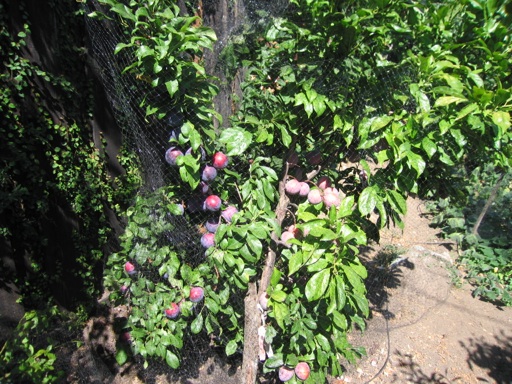
I really enjoy growing sugar pie pumpkins and butternut squash. I have found that they are both easy to grow from seed as long as they get regular water. I planted several groups of seeds last March. The vines are very long now and have set many fruits, even though I haven’t fertilized them. The vines can take up a lot of space, which is why I planted the seeds where the vines can grow in between our fruit trees. I planted them directly in the ground, not in our raised beds, because the vines would just grow out of the beds and across our paths between the beds. Some of the pumpkins have even grown roots directly from the vines into the ground.
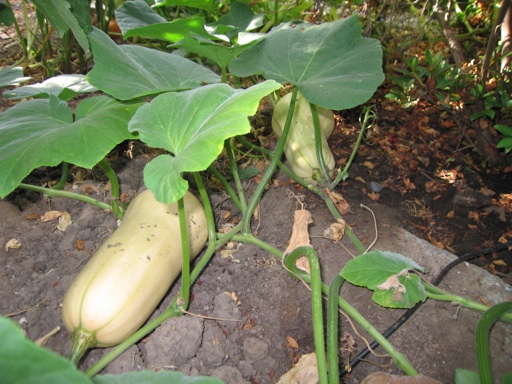
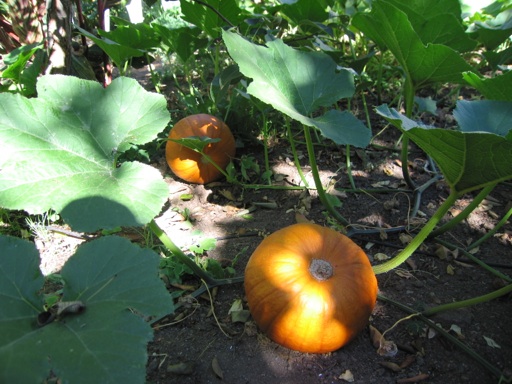
We are also growing Siam Queen (Thai) basil this year. I planted the seeds in pots in our mini-greenhouse in April and transplanted the seedlings into one of our raised beds in May. They only grow in warm weather, and it can get cold in April here. The plants grew slowly at first, but they are now starting to grow more rapidly. Their leaves have a strong scent that is similar to licorice, and their flowers are an attractive purple color. Also, they don’t seem to attract insects.
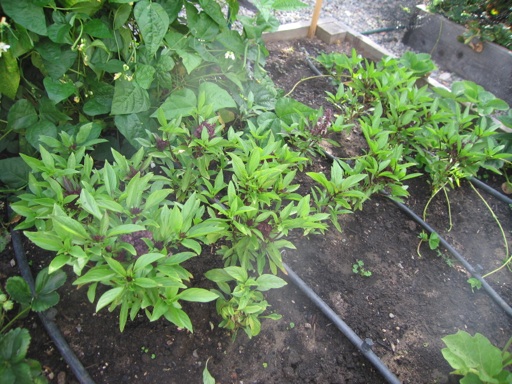
Our purple Dahlias have been full of flowers for several weeks. We are also growing them in raised beds where they get plenty of water and rich composted soil. Unfortunately, they are already getting mildew on their leaves, which happens every year around this time.
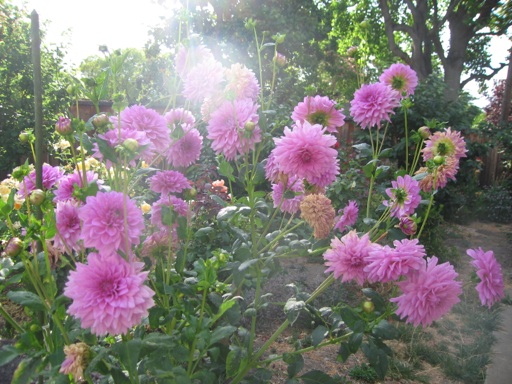
I planted corn seeds in mid-March this year, which is the earliest I have ever planted them. We almost never get frost here after March 1. I planted the peaches and cream variety, and ended up with about 18 plants. I always plant at least 15 corn seeds in a planting to ensure proper pollination. I started harvesting corn ears the first week of this month. They were very tasty.
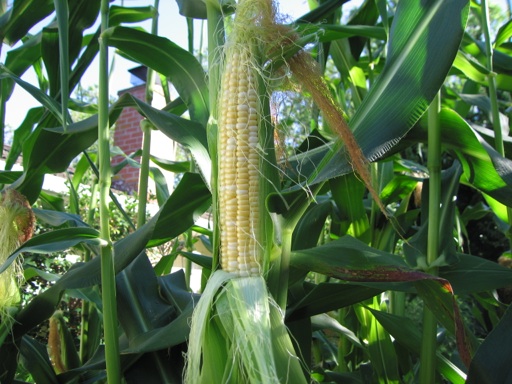
I harvested some of the last ears today. Several of the stalks had two ears, and a few stalks grew outshoots that themselves grew an additional ear of corn. I have more corn in another bed that I planted in June. They should be ready to harvest in October.
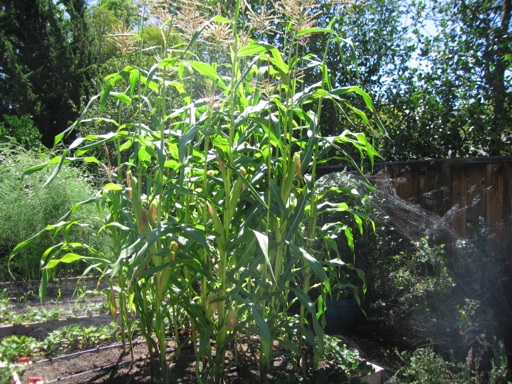
I planted Albion strawberries in pots with potting soil in May. I had not grown this variety previously. I have been picking strawberries from the Albion plants for over a month now, and they have exceeded my expectations. They have been continuously producing very sweet and large berries. They are much sweeter than Chandler, which are on the tart side in our yard. I think I will be planting more Albion strawberries in the future. So far the Albion plants have not produced many runners, unlike our Sequoia strawberries, which are prolifically producing runners right now.
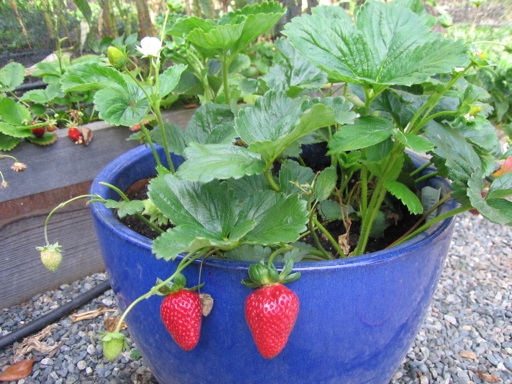
July 26 2014 | Basil and Corn and Dahlias and Plums and Pumpkin and Squash and Strawberries | Comments Off on Mid-summer post
Our strawberry harvest started the second week of April, which is very early for our area. But, their growth and fruit production started to slow down around mid-May. At that point, I realized that our strawberry plants weren’t getting enough water from my automatic sprayers. For the past few weeks, I’ve been watering them by hand nearly everyday, and they seem to be responding to the extra water.
Our strawberry plants are now growing again and getting new flowers. In the past, I’ve thought that fertilizing regularly was the key to getting lots of strawberries for many months. But now I’m realizing, they just need lots of water, preferably a daily soaking.
Below is a picture of some of our Chandler strawberries growing in a pot. Chandler is one of my favorite varieties, because it produces large strawberries on strong stems. I have also been growing Sequoia strawberries for years.
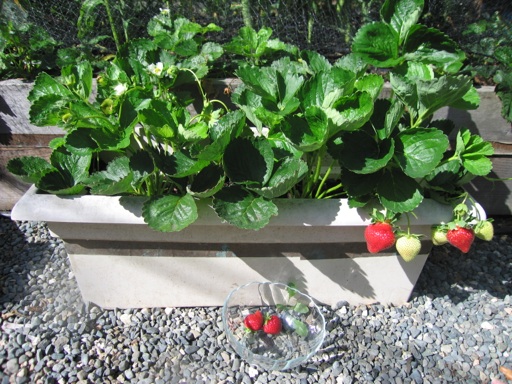
Last week, I planted some everbearing Albion strawberries, which I hope will produce berries in mid and late summer after the June bearing varieties are finished. This is a variety that I haven’t grown before.
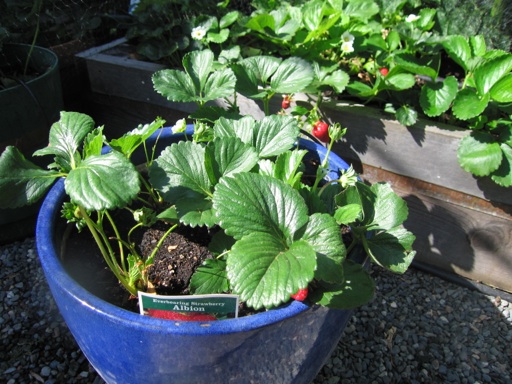
I’ve also been harvesting cherries from our Rainier and Royal Rainier cherry trees this past week. The Royal Rainer cherries are very sweet and mild (picture below). Our Royal Rainier tree has produced cherries nearly every year we’ve had it, which is about 5 years now. It has consistently produced more fruit than our other two cherry trees, even though it is smaller than our other cherry trees.
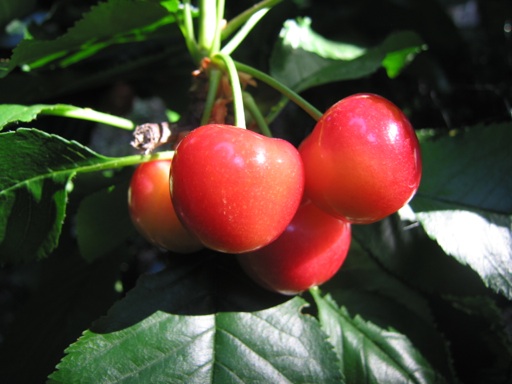
Our Rainer cherries are more tart, even though the tree is a year older than the Royal Rainer and visually the cherries look very ripe. Also, the tree doesn’t have many cherries, and this is the first year it has had more than 2 cherries. However, our Rainier tree is a very vigorous grower. It has grown to about eight feet tall and as wide despite regular pruning as shown below.
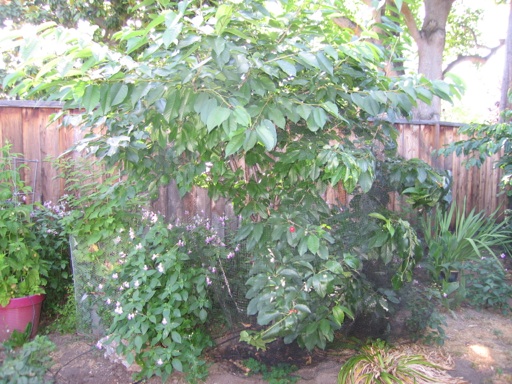
Our third cherry tree is a Bing, which also has its first significant crop of cherries this year. Its fruit is just starting to get a deep red color. I’m leaving the fruit on the tree, until they get nearly black. And of course, I have bird netting on all three trees. So far, it has prevented even a single cherry from being pecked at, as far as I can tell.
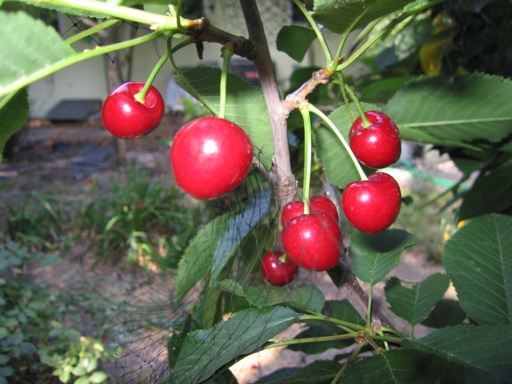
Our blueberry harvest also started the second week of April, which is about a month earlier than usual. I was picking blueberries from our Misty plant in April and early May. Moving it to a sunnier location and the warm weather we had this spring seem to be the reasons for the early harvest. I also currently have the blueberry varieties Southmoon, Sunshine Blue, Jubilee, Reveille, Sharpblue, and O’Neal. These others starting ripening around mid-May, and they still each have many underripe berries left on their branches. I have all 7 of our blueberries in pots, and they seem to be thriving in them as long as I keep them well hydrated. They definitely dry out faster in the pots than in the ground. Below is a photo of a few of the blueberries that are growing next to a fence, which makes it easier to net them.
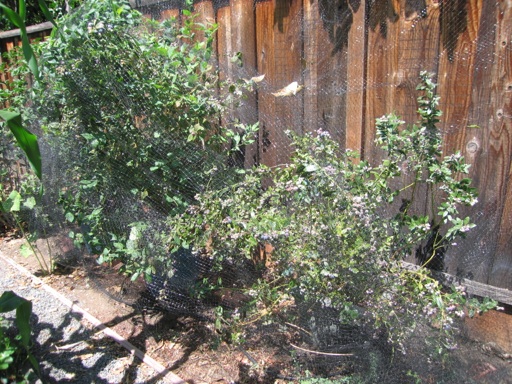
And here is what the same plants looked like in bloom on March 2.
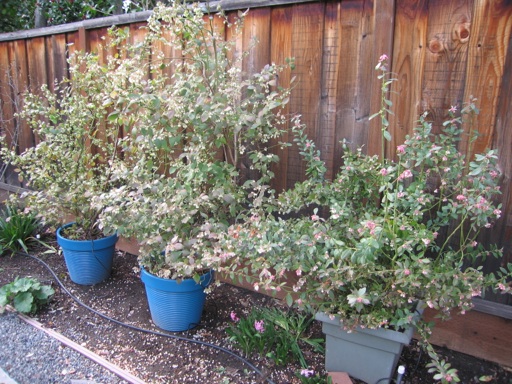
I harvested so many blueberries this week that I had enough to make a blueberry pie and still had some left over.
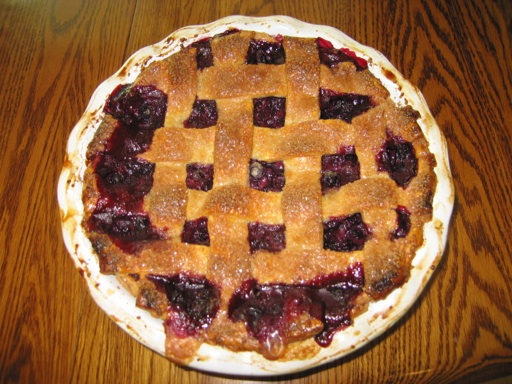
June 06 2014 | Blueberries and Cherries and Strawberries | Comments Off on Berries and Cherries
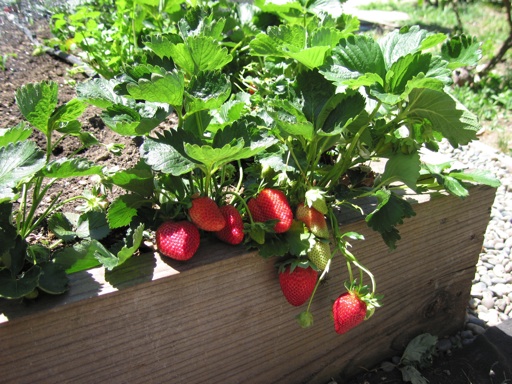
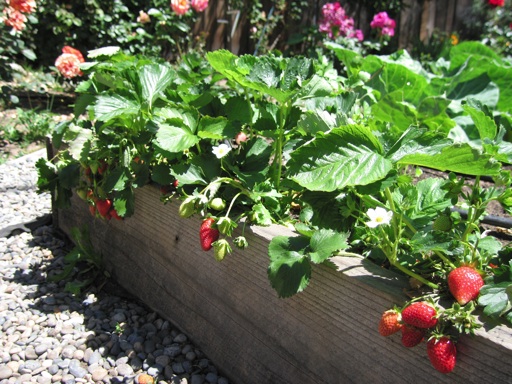
I have been growing strawberries in my backyard for years, but I have never gotten more than about a half a dozen ripe berries before the first week of May. This year, I started getting a few ripe strawberries two weeks ago. Over the past 10 days, I have picked a bowl full of strawberries every few days. I have never had so many ripe strawberries before the end of April.
I attribute the early strawberries mainly to the weather. We have had warmer than average weather for the past couple of months, with many more days in the 70s and 80s in April than we typically receive. The average afternoon high temperatures here in April are in the upper 60s to low 70s. Another factor may be the variety of strawberry that I grow. I used to grow mainly Sequoia strawberries. Now most of my strawberries are Chandler, although I still have some Sequoias. Sequoias have a better flavor, but Chandler has many other advantages that make it my favorite strawberry.
Chandler produces many more berries than other varieties I have grown (which include Quinault, Seascape and Aromas), and its berries are typically larger than Sequoia. Also, Chandler doesn’t grow as many leaves as Sequoia, which makes it easier to find the berries and makes for less cover for snails and slugs to hide in. Sequoias grow lots of medium to small leaves, while Chandler tends to grow fewer but larger leaves. Finally, Chandler berries are firmer than Sequoia and less prone to rotting. I am growing all of my strawberries this year as a border around my raised garden beds.
Most of the strawberry plants I am growing now grew as runners from plants that I bought from a nursery and planted last spring. Although some people say to cut off strawberry runners, I let them grow, because I have found that strawberry runners from the previous year grow well and produce lots of berries in the next season. Often, they produce better than nursery transplants in my experience. And since strawberries only last a few years, you either have to let the runners grow or buy nursery transplants every few years to replace the old ones.
April 30 2013 | Strawberries | Comments Off on Early Strawberries
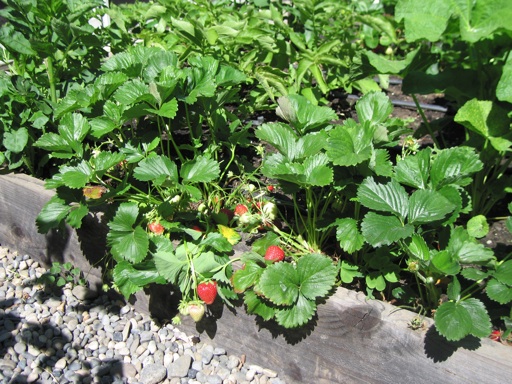
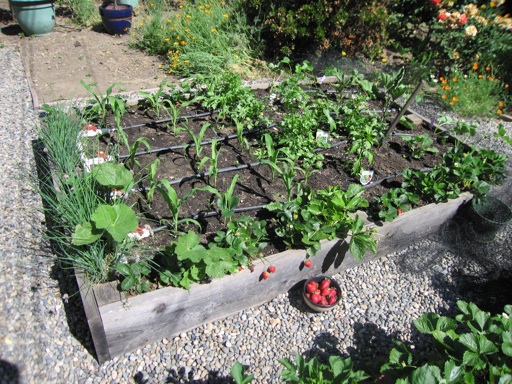
When I last posted about strawberries back in 2009, I was still growing most of our strawberries in pots. Back then, I was having problems with slugs eating the berries at night and hiding under the pots in the daytime. Copper tape and beer didn’t stop them. So over the past few years, I have been phasing out the berries growing in pots. Last year, I planted new strawberry plants as a border around each of our 4 raised beds. I planted the varieties Sequoia, Seascape, and Chandler.
They didn’t produce many berries their first year. However, starting around May 1 this year, they finally started producing a lot of berries. I have been harvesting about 4 pint size bowls of berries per week for each of the past 3 weeks. The most productive variety by far this year is Chandler. Our Chandler strawberry plants are producing many large berries, from only about a dozen plants. The Chandler berries are large and firm and don’t rot or turn brown quickly (first picture above). I have been fertilizing our strawberries about once every 2 weeks.
I have at least two dozen Sequoia strawberry plants. The Sequoia strawberries have lots of leaves, but they haven’t been as productive as the Chandler strawberries. I am not sure why the Sequoias haven’t been producing as much as they did in the past when I grew them in pots. I still have a few newer Sequoias in pots, and they aren’t producing many berries either. Also, the Sequoia berries tend to be small (many of them are very small) and often the berries start to turn brown or rot on one side before they are fully ripe. In my opinion, the Sequoia strawberries have the best flavor of these three varieties, assuming they are fully ripe, not too small, and not browning yet, which eliminates at least half of the harvest.
For now, Chandler is my favorite variety. I prefer plants that produce lots of large berries as opposed to few small ones. Just this week, I planted more Chandler strawberries plants that I purchased from a local nursery.
The Seascape strawberries are large and firm like the Chandler strawberries, but they haven’t been as productive as Chandler. Seascape is an ever bearing variety, which tends to produce more berries in the summer. Chandler and Sequoia are long day varieties, which tend to produce the most berries from mid-spring to early summer.
As for the slugs and snails, they still eat a few of the berries in the raised beds, but it’s easier to protect them with Sluggo and netting than when they were crowded into pots.
May 20 2012 | Strawberries | Comments Off on Strawberries
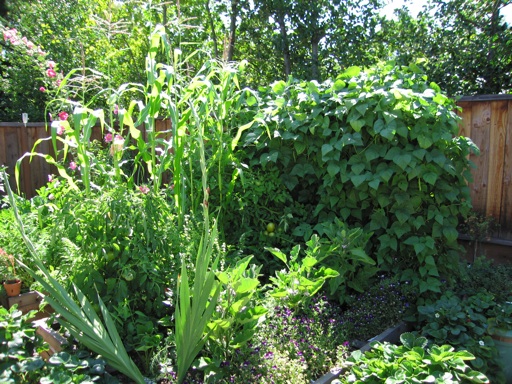
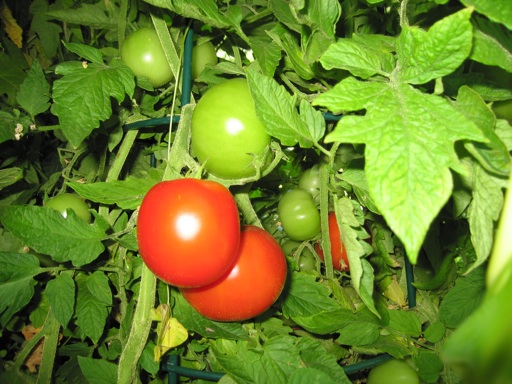
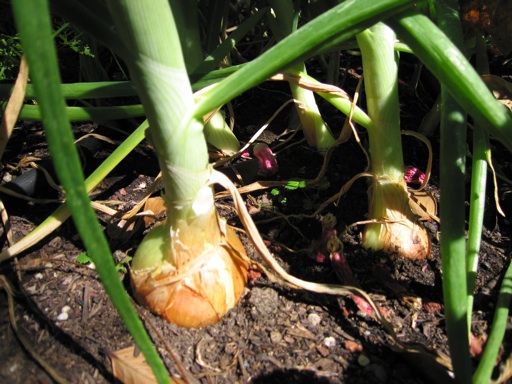
We have been growing vegetables in two 6′ x 7′ raised beds since last summer. In these two small beds, we are growing several different types of fruits and vegetables including peppers, eggplant, zucchini, green beans, tomatoes, corn, carrots, onions, cantaloupe, and honey dew.
Our most successful plants so far are the green beans and zucchinis. They are producing more green beans and zucchinis than we can eat. Only a few of the tomatoes on our two tomato plants are have ripened so far (see second picture), but there are dozens of green tomatoes hanging on the vines.
Several of our carrots and onions are just about ready to harvest. The third picture shows some of the walla walla onions we are growing this season. Our corn stalks have reached their maximum height and are now starting to grow small corn ears.
Our eggplants and peppers are growing several small fruits. Although the peppers have not grown very much since I planted them in April. They seem to be getting crowded by the beans, carrots, and tomatoes growing next to them. One of the problems with growing so many different types of plants in a small area is that the slow growing plants like peppers and eggplant tends to get crowded by the faster growing plants. Next year, I may try to plant the slower growing plants together in one bed and the faster growing plants in the other bed.
I haven’t fertilized most of the plants in our vegetable garden since mid-May. I was fertilizing them with water soluble fertilizer for about the first 6 six weeks after planting. After that, most of the vegetables started growing so fast that I decided to stop the fertilizing. I have only been continuing to fertilize the eggplants and peppers in an attempt to get them to grow more.
I have also been fertilizing our strawberries about once a week. I know that sounds like a lot of fertilizer, but they have been producing strawberries continuously since early May. They show no signs of slowing down their fruit production yet. I have been harvesting a small bowl full of berries every few days for over two months. I attribute the huge production of berries to all the fertilizer. Last year, they stopped producing berries in early June. But as soon as I started fertilizing them, they begin to produce berries again.
Our strawberries are growing in pots around the raised beds, which makes it easy to pick them. Strawberries tend to rot quickly when the fruits are lying directly on damp soil. The berries mostly hang over the edges of the pots, so the berries stay dry.
July 12 2009 | Onions and Strawberries and Tomatoes and Vegetables | Comments Off on Vegetable Garden Update
Next »






















